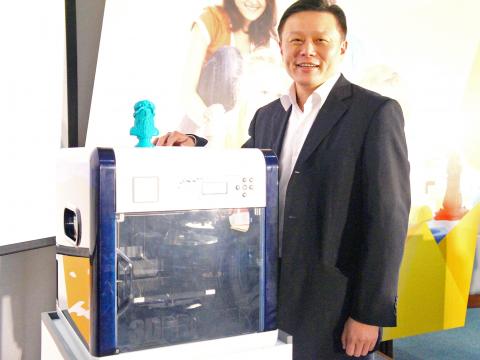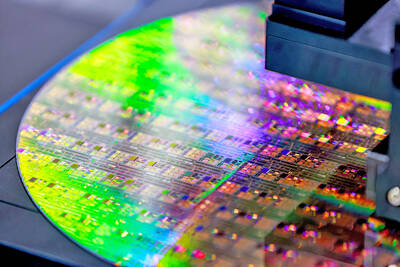XYZprinting Inc (三緯), the second-largest producer of 3D printers in the world, yesterday launched its first 3D food printer. The device — able to print edible chocolate, cookies and pizza — brings 3D printing technology to kitchens.
XYZprinting — the 3D printer arm of the New Kinpo Group (新金寶集團) — said the 3D food printer is a milestone for the company as it combines manufacturing technology with the food industry.
The printer is the company’s first device to use ingredient capsules to produce edible items.

Photo: CNA
“We are working with different suppliers of food ingredients to go with the machine,” company chairman Simon Shen (沈軾榮) told a media briefing yesterday. “We believe that in the future 3D food printers might be used in space to print out food for astronauts, a topic NASA is researching at the moment.”
XYZprinting’s 3D food printer would be on the market by June next year, Shen said. The device would retail at an affordable price, compared with rivals’ expensive price tags of between US$3,000 and US$5,000 per unit, he said.
With new models to hit the market next year, the Greater Taipei-based company aims to more than triple its sales of 3D printers to between 120,000 and 150,000 units next year, from this year’s estimated 40,000 units, Shen said.
The one-year-old company also expects to make a profit next year after reaching the break-even point this quarter, Shen said. The gross margin for its 3D printers is higher than 10 percent, he added.
Research house Gartner Inc forecast that global 3D printer shipments next year would grow to 217,350 units, compared with 108,151 units recorded this year. Shipments would more than double every year over the next four years to reach more than 2.3 million units in 2018, Gartner said last month.
“Next year, we plan to introduce high-end 3D printers for business use [such as jewelry companies]. We are not only capable of making low-cost machines,” XYZprinting’s market development division senior manager Gary Shu (舒家誠) said.
Yesterday, XYZprinting also launched a 3D printer with a built-in scanner, which is the company’s first 3D-printing machine combining a printer and a scanner.
“The new 3D printer should provide 3D-modeling capability for the ordinary consumer,” Shen said.
The device, code-named da Vinci Aio, is available via online retailers, including Taiwan’s PChome Store Inc (商店街市集) and the US-based Amazon.com.
The 3D printer has a price tag of NT$26,990, which is much lower than the NT$76,560 asked for a similar model by AIO Robotics, according to XYZprinting.

Taiwan’s rapidly aging population is fueling a sharp increase in homes occupied solely by elderly people, a trend that is reshaping the nation’s housing market and social fabric, real-estate brokers said yesterday. About 850,000 residences were occupied by elderly people in the first quarter, including 655,000 that housed only one resident, the Ministry of the Interior said. The figures have nearly doubled from a decade earlier, Great Home Realty Co (大家房屋) said, as people aged 65 and older now make up 20.8 percent of the population. “The so-called silver tsunami represents more than just a demographic shift — it could fundamentally redefine the

The US government on Wednesday sanctioned more than two dozen companies in China, Turkey and the United Arab Emirates, including offshoots of a US chip firm, accusing the businesses of providing illicit support to Iran’s military or proxies. The US Department of Commerce included two subsidiaries of US-based chip distributor Arrow Electronics Inc (艾睿電子) on its so-called entity list published on the federal register for facilitating purchases by Iran’s proxies of US tech. Arrow spokesman John Hourigan said that the subsidiaries have been operating in full compliance with US export control regulations and his company is discussing with the US Bureau of

Businesses across the global semiconductor supply chain are bracing themselves for disruptions from an escalating trade war, after China imposed curbs on rare earth mineral exports and the US responded with additional tariffs and restrictions on software sales to the Asian nation. China’s restrictions, the most targeted move yet to limit supplies of rare earth materials, represent the first major attempt by Beijing to exercise long-arm jurisdiction over foreign companies to target the semiconductor industry, threatening to stall the chips powering the artificial intelligence (AI) boom. They prompted US President Donald Trump on Friday to announce that he would impose an additional

Pegatron Corp (和碩), a key assembler of Apple Inc’s iPhones, on Thursday reported a 12.3 percent year-on-year decline in revenue for last quarter to NT$257.86 billion (US$8.44 billion), but it expects revenue to improve in the second half on traditional holiday demand. The fourth quarter is usually the peak season for its communications products, a company official said on condition of anonymity. As Apple released its new iPhone 17 series early last month, sales in the communications segment rose sequentially last month, the official said. Shipments to Apple have been stable and in line with earlier expectations, they said. Pegatron shipped 2.4 million notebook